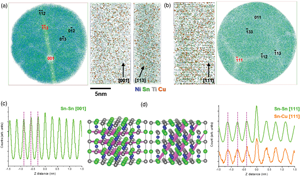Published online by Cambridge University Press: 28 July 2021

Cu-doping and crystallographic site occupations within the half-Heusler (HH) TiNiSn, a promising thermoelectric material, have been examined by atom probe tomography. In particular, this investigation aims to better understand the influence of atom probe analysis conditions on the measured chemical composition. Under a voltage-pulsing mode, atomic planes are clearly resolved and suggest an arrangement of elements in-line with the expected HH (F-43m space group) crystal structure. The Cu dopant is also distributed uniformly throughout the bulk material. For operation under laser-pulsed modes, the returned composition is highly dependent on the selected laser energy, with high energies resulting in the measurement of excessively high absolute Ti counts at the expense of Sn and in particular Ni. High laser energies also appear to be correlated with the detection of a high fraction of partial hits, indicating nonideal evaporation behavior. The possible mechanisms for these trends are discussed, along with suggestions for optimal analysis conditions for these and similar thermoelectric materials.